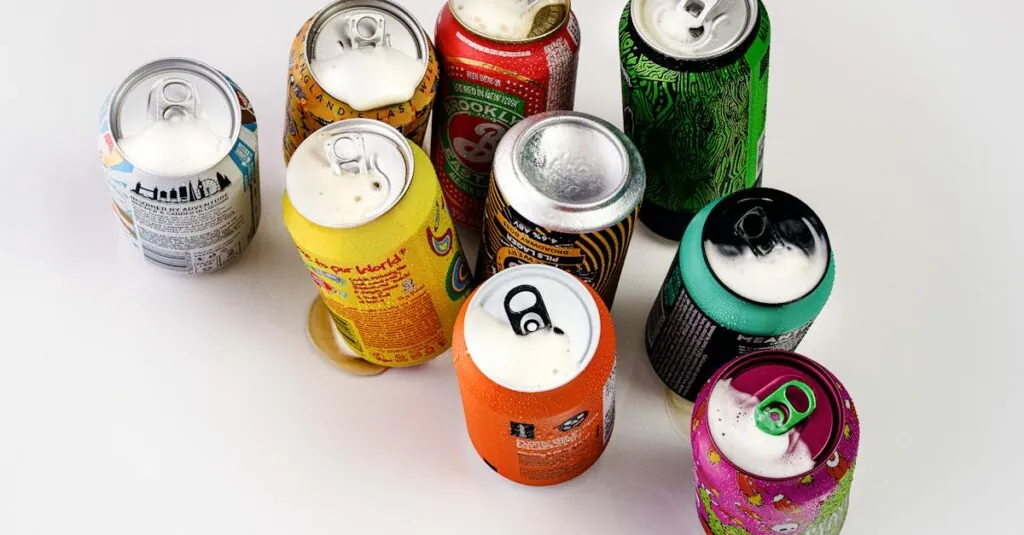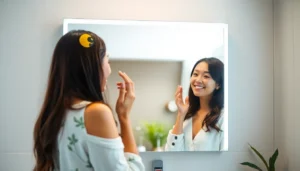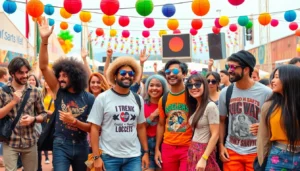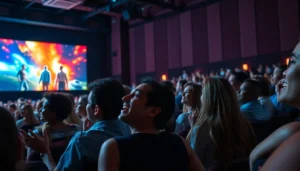Table of Contents
ToggleIn a world where trends come and go faster than a TikTok dance challenge, the pop aesthetic stands out like a neon sign in a sea of beige. This vibrant visual style captures the essence of youth culture, blending bold colors, playful patterns, and nostalgic references that make it impossible to ignore. It’s not just a trend; it’s a lifestyle that celebrates everything from bubblegum pop music to the quirky charm of retro cartoons.
Imagine walking into a candy store where every corner bursts with eye-catching hues and whimsical designs. That’s the pop aesthetic for you! It’s all about embracing fun and creativity, inviting everyone to express themselves without a hint of seriousness. Whether you’re a die-hard fan or just curious about this colorful phenomenon, dive in and discover how the pop aesthetic can transform your world into a playful paradise.
Understanding Pop Aesthetic
Pop aesthetic captures vibrant visual experiences with its bold colors, playful patterns, and nods to nostalgia. This art form reflects youth culture, inspiring creativity and fun in daily life.
Definition and Origin
Pop aesthetic emerged during the mid-20th century, finding its roots in pop art. Artists like Andy Warhol and Roy Lichtenstein popularized this movement, showcasing mass culture elements. It celebrates commercial imagery while merging fine art with everyday visuals. Originating in the 1950s and 60s, pop aesthetic draws influence from music, fashion, and media. The style emphasizes accessibility, welcoming everyone to engage with its colorful energy.
Key Characteristics
Bold color palettes dominate the pop aesthetic, often featuring bright pinks, yellows, and blues. Playful patterns, such as polka dots and stripes, enhance its vibrancy. Nostalgic elements, including retro cartoons and vintage advertising styles, evoke memories from childhood. Emotional expression is vital; whether through whimsical designs or exaggerated forms, it sparks joy. Pop aesthetic also thrives in various mediums, encompassing fashion, graphic design, and interior decor, creating a multifaceted cultural experience.
Influences on Pop Aesthetic
Pop aesthetic draws inspiration from various cultural elements, particularly music and media, alongside visual art and design.
Music and Media
Bubblegum pop music plays a significant role in shaping the pop aesthetic. This genre features catchy melodies, upbeat rhythms, and vibrant visuals that encourage carefree expression. Artists like Katy Perry and Miley Cyrus embody elements of pop aesthetics through colorful music videos and energetic performances. Additionally, social media platforms like Instagram and TikTok amplify this aesthetic, showcasing bold fashion choices and playful themes. Users share visually striking content, inviting interaction and creativity. Nostalgic references from the 1990s and 2000s also resonate with audiences, fueling trends that celebrate youth culture. The connection between music and visual elements fosters a vibrant, multisensory experience that reinforces the core of pop aesthetic.
Visual Art and Design
Visual art and design significantly influence the pop aesthetic’s development. Influential artists like Andy Warhol and Roy Lichtenstein paved the way with their incorporation of commercial imagery and bright color palettes. Their works inspire modern designers to embrace playful patterns and nostalgic themes in various creative projects. Graphic design, in particular, thrives on bold typography and whimsical illustrations, capturing the essence of pop culture. Interior decorating also embraces this aesthetic, with furniture and decor featuring vivid colors and cheerful motifs. This cross-disciplinary interplay enriches the pop aesthetic, ensuring its presence remains prominent across numerous visual mediums. The result is an eclectic blend of artistry that invites viewers to engage joyfully with the world around them.
Cultural Impact of Pop Aesthetic
The pop aesthetic shapes various cultural dimensions, notably in fashion and social media. Its vibrant elements influence style choices and online expressions.
Fashion Trends
Pop aesthetic significantly impacts fashion trends, characterized by colorful garments and playful accessories. Designers frequently incorporate bold colors and nostalgic motifs into their collections. Retail brands embrace this aesthetic by showcasing pieces that evoke childhood nostalgia and vibrant visuals. Influencers often promote outfits featuring pastel shades, graphic prints, and whimsical designs, making them popular. This trend cultivates a sense of joy and creativity, helping individuals express their unique identities. Artists and brands that adopt these styles create wardrobe staples that resonate with youth culture.
Social Media Presence
Social media platforms amplify the pop aesthetic’s reach, enhancing its cultural significance. Instagram feeds overflow with vibrant imagery showcasing bold fashion choices and playful themes. TikTok users frequently share videos that capture the essence of this aesthetic, featuring colorful visuals, catchy music, and engaging content. Many creators replicate iconic pop art visuals, further fostering nostalgic connections. The aesthetic thrives in digital spaces, where users connect over shared interests. This collective engagement fosters a community that celebrates individual expression and joy, making the pop aesthetic a lively cultural force.
Critiques of Pop Aesthetic
Critiques of the pop aesthetic involve discussions around authenticity and commercialization, as well as its evolution over time. These conversations reflect ongoing tensions within the vibrant style, highlighting its complexities.
Authenticity and Commercialization
Authenticity remains a point of contention within the pop aesthetic. Critics argue that commercialization dilutes the original intent, transforming artistic expression into mere consumerism. This occurrence leads to questions about the genuine motivations of brands adopting colorful designs. Authentic creators often find themselves eclipsed by mass-produced items lacking individuality. As commercial interests dominate, the aesthetic’s vibrant essence risks becoming a fashion fad stripped of its deeper cultural significance. When brands craft nostalgia-driven marketing campaigns, they may overlook the authenticity that first attracted audiences to this lively aesthetic.
Evolution Over Time
The pop aesthetic has undergone significant changes since its inception. Originally rooted in the pop art movement, its evolution reflects shifts in cultural trends and societal values. Artists adapted to technological advancements, expanding the aesthetic’s reach through digital platforms. Initial expressions of playful imagery transformed into diverse interpretations across various mediums. New generations reinterpret classic elements, blending them with contemporary styles. As societal influences shift, the aesthetic continues to evolve. Current manifestations resonate with social media users, illustrating the adaptability of this colorful expression across different eras. Each transition serves as a testament to its lasting impact on culture.
The pop aesthetic stands as a celebration of color and creativity that resonates deeply with contemporary culture. Its playful nature invites individuals to express themselves joyfully while embracing nostalgia in a modern context. As it continues to evolve, the aesthetic’s adaptability ensures its relevance in today’s fast-paced world.
Whether through fashion, art, or social media, the pop aesthetic encourages a vibrant dialogue between past and present. This lively cultural force inspires a sense of community where self-expression thrives. By embracing this aesthetic, individuals can transform their environments and lives into colorful reflections of their unique identities.







